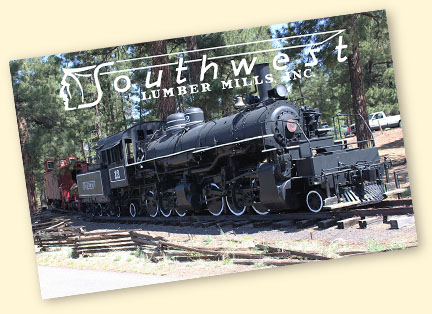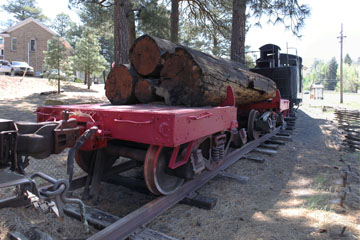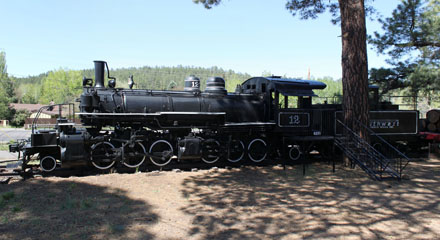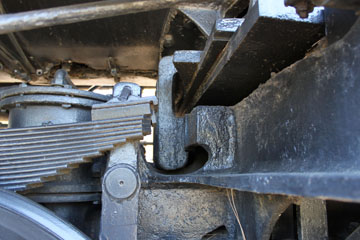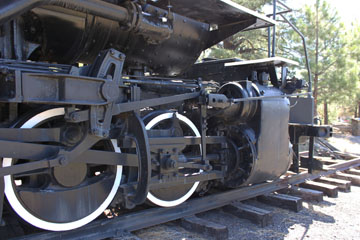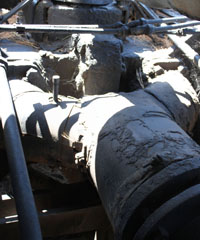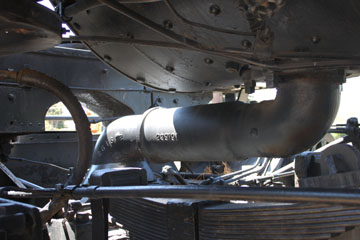#12 is a 2-6-6-2 compound Mallet on display at the Arizona Historical Society's Pioneer Museum on Nth Fort Valley Rd in Flagstaff. The museum exhibits reflect the history and life of Flagstaff and northern Arizona, including ranching, logging and transportation. #12 and its small consist are the only railroad related exhibits.
The locomotive was one of two built by Baldwin for Hammond Lumber Company in Mill City, OR, in 1929 (#5 & #6). Both were built as split saddle tanks (i.e. with two water tanks, one on either side of the boiler). You can see another saddle tank 2-6-6-2 built by Baldwin on the Black Hills Central Railroad page of this website.
Originally number #6, in 1931, the company renumbered the locomotive #12 when it moved to a mill in Samoa, CA. After twenty-two years with the company, #12 was then sold in 1951 to the Arcata & Mad River Railroad in Blue Lake, CA. In 1956, it moved to Southwest Lumber Mills in Flagstaff. For a time, Southwest ran #12 with a large tank car as an auxiliary tender. After adding a normal rectangular tender, the original fuel bunker was removed but the tanks retained. In 1959, when Southwest Lumber Mills became Southwest Forest Industries, #12's two saddle tanks were removed.

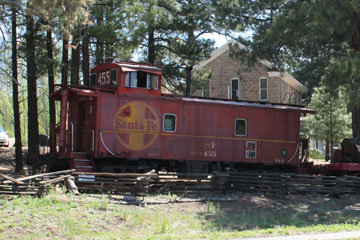
Southwest Forest Industries donated #12 to Coconino County in 1960 and it initially went on display in Coconino County Park in Flagstaff. In 1994, it was moved to its current location at the Pioneer Museum.
The locomotive is well looked after. Below and right, it is on display with an unnumbered log car and ATSF CE-2 cupola Caboose #999455 built by ATSF in 1942. It was one of two hundred and twenty-three rebuilt for pool service at the Santa Fe's San Bernardino, CA, shops between 1969 and 1970, and was in use into the late 1980s.


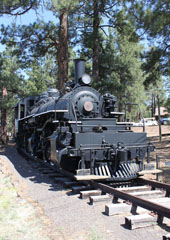
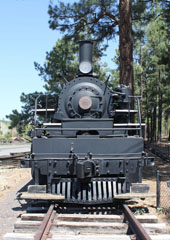
According to Robert A. LeMassena (Articulated Steam Locomotives of North America, Volume II, p.69), #12 is one of thirty logging Mallets built by Baldwin between 1910 and 1937. Six other articulated single-expansion logging locomotives were also built by Baldwin, but these are not true Mallets like #12.
A true Mallet, or compound locomotive, uses steam generated by the boiler twice. Steam is fed first to the high pressure cylinders. The exhaust steam from these is then fed to larger, low pressure cylinders at the front of the locomotive.
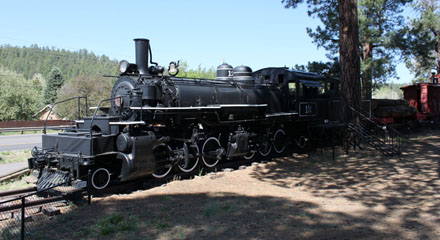

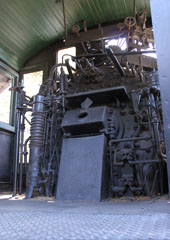
Above, two views of #12’s backhead. It remains in quite good condition despite the fact that the cab is unprotected and easily accessed.
An oil burner, the locomotive has a 26.2 sq ft grate, 128 sq ft firebox and total heating surface of 2,012 sq ft, including 358 sq ft superheating. Operating at a boiler pressure of 200 psi, it delivered 37,545 lbs tractive effort. Below, the front, low pressure cylinders are 26” x 24”, the rear, high pressure cylinders 17” x 24”. Each of the two 44” driver wheelbases is 8’ with a total engine wheelbase of 23’ 8”
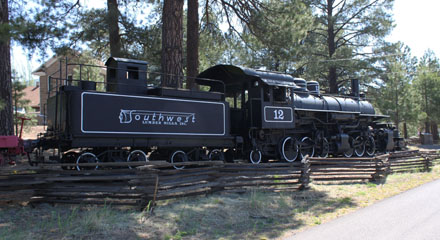
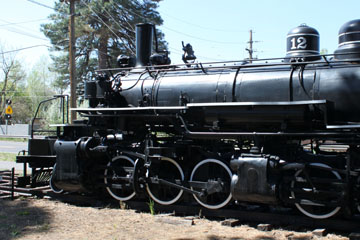
Compounding was first applied commercially by the Swiss engineer Anatole Mallet (1837-1919) in 1876 to a series of small, 2 cylinder 0-4-2 tank locomotives for the Bayonne-Anglet-Biarritz Railway in France. He gave his name to this type of locomotive.
Mallet also introduced locomotive articulation, in which the rear engine is rigidly attached to the main body and boiler of the locomotive, while the front engine rides on a separate truck attached to the rigid rear frame by a hinge so that it can swing from side to side
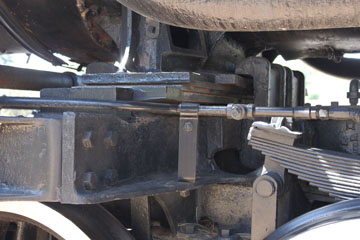
To make articulation possible, the front end of the boiler rests on a bearing on top of the swinging front engine frame.
Above, a view of the bolster underneath the front of the boiler. Although connected to the boiler, it does not provide any support on the front engine frame for the boiler’s weight. As the locomotive takes curves, the bolster slides over the plate fixed to the front frame. Note the “G” guide on the right of the photo. It helps stabilise motion. The photo below shows a close up of the frame plate, guide and bolster.
Above left, the rear, high pressure cylinder saddle is rigidly fixed to the boiler. Steam is piped from the front of the locomotive entering the steam chest at the far left of the photo.
Above right, the front engine frame is connected by a hinge and pin to the rear cylinder saddle (the hinge is in the lower part of the photo). Steam exhausted from the high pressure cylinders is piped along the central axis of the front frame (the pipe, called a receiver, is in the middle of the photo). A ball joint inside the saddle allows the pipe to pivot.
Below, steam from the rear cylinders is conveyed to #12’s front cylinders through this Y-pipe.
Baldwin’s logging Mallets were of various types, built with tanks or tenders, wood, coal or oil burning (although wood and coal burners were rare, as they created sparks that could ignite forest fires).
Above, the right hand front Walschaert valve gear and cylinder. Note the elbow off the combination lever connecting to the oil pump to lubricate the cylinders. Below, the exhaust pipe from the low pressure cylinders to the smoke box. Ball joints at either end allow the pipe to swivel with the movement of the front frame.
As well as BHC #110 on the Black Hills Central page, you can see photos of two more Baldwin
2-6-6-2 logging Mallets, Weyerhaeuser Timber #6 and United States Plywood #11 on the Northwest Railway Museum page of this website.
Relatively small, most weighed between 200,000 and 300,00 lbs (#12 weighs 220,000 lbs) and nearly all worked in the Pacific Northwest.
Their running gear was designed to be particularly flexible to handle the sharp curves and undulating track characteristic of logging railways.
